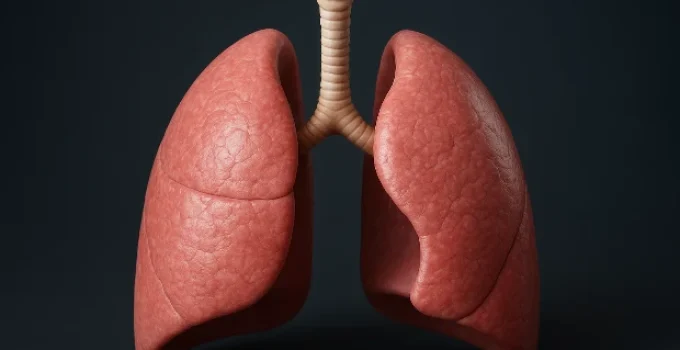How Do the Lungs Work?
Every time you breathe in and out, your lungs are hard at work. But how do they actually do it? What’s going on inside your chest while you’re walking, talking, or even sleeping? The lungs are the center of your respiratory system, and they perform one of the most important jobs in your body: bringing in oxygen and getting rid of carbon dioxide.
Let’s explore exactly how these sponge-like organs keep you alive with every breath.
🔍Dive Deeper
- Where Are Your Lungs Located?
- The Parts Inside Your Lungs
- What Happens When You Breathe In?
- How Does Gas Exchange Work?
- What Happens When You Breathe Out?
- 🎯 Final Thoughts
- 📚 References
🫁Where Are Your Lungs Located?
Your lungs are located in your chest, or thoracic cavity, protected by your ribcage. You have two lungs, but they’re not the same:
- The right lung is larger and has three lobes.
- The left lung is smaller with two lobes to make room for your heart.
They rest on top of a muscle called the diaphragm, which helps them move during breathing.
💥 Did you know? Your lungs take up about 40% of your chest space—but they’re light, weighing just over 2 pounds combined! [1]
𖣂The Parts Inside Your Lungs
Inside each lung is a tree-like structure made of airways and air sacs:
- Bronchi: Two large tubes that branch from your trachea into each lung.
- Bronchioles: Smaller branches of the bronchi, like twigs on a tree.
- Alveoli: Tiny air sacs at the ends of bronchioles where gas exchange happens.
- Capillaries: Tiny blood vessels surrounding the alveoli.
These structures give your lungs a huge surface area in a small space.
| Lung Structure | Function |
|---|---|
| Bronchi & bronchioles | Carry air through the lungs |
| Alveoli | Exchange oxygen and carbon dioxide |
| Capillaries | Transport gases to and from the blood |
🎉Fun fact: If you stretched out all the alveoli in your lungs, they’d cover the size of a tennis court—about 70 square meters! [2]
🌬️What Happens When You Breathe In?
Breathing in is called inhalation. Here’s what happens:
- The diaphragm contracts and flattens.
- Your rib muscles lift the ribcage up and out.
- This creates more space in the chest, causing air to rush into the lungs through your nose or mouth.
The air travels down your trachea, into the bronchi, then into the bronchioles, and finally reaches the alveoli.
📝 Interesting fact: The air you breathe contains about 21% oxygen—the part your body needs most. [3]
💨How Does Gas Exchange Work?
At the alveoli, something amazing happens: gas exchange. This process works by diffusion, where gases move from an area of high concentration to low concentration:
- Oxygen in the alveoli moves into nearby capillaries and enters the blood.
- Carbon dioxide, a waste gas from your cells, moves from your blood into the alveoli.
This exchange happens millions of times per minute, providing your cells with oxygen and cleaning out carbon dioxide.
📊 Quick stat: Your lungs perform gas exchange with about 5 liters of blood every minute! [4]
🌬️What Happens When You Breathe Out?
Breathing out is called exhalation. It works like this:
- The diaphragm relaxes and moves upward.
- The rib muscles let the ribcage fall back down.
- This reduces the space in your chest and pushes carbon dioxide-rich air out of your lungs.
The air travels out through the same path it came in—alveoli → bronchioles → bronchi → trachea → nose or mouth.
༄ Cool fact: The air you exhale contains about 100 times more carbon dioxide than the air you inhaled. [5]
🎯 Final Thoughts
So, how do the lungs work? Your lungs are more than just sacks of air—they’re high-tech oxygen machines. With every breath, they bring in fresh oxygen and remove harmful carbon dioxide, helping your entire body work properly. From the alveoli to the diaphragm, every part of the lung works together like a team. Understanding how the lungs work helps you appreciate how much your body does behind the scenes—just to keep you breathing.
📚 References
- National Heart, Lung, and Blood Institute. “How the Lungs Work.”
https://www.nhlbi.nih.gov/health/how-lungs-work - American Lung Association. “Structure and Function of the Lungs.”
https://www.lung.org/lung-health-diseases/how-lungs-work/structure-function - NASA Earth Observatory. “Air Composition.”
https://earthobservatory.nasa.gov/features/Airborne/airborne2.php - Cleveland Clinic. “Lung Function and Gas Exchange.”
https://my.clevelandclinic.org/health/articles/9480-respiratory-system - Khan Academy. “Gas Exchange in the Lungs.”
https://www.khanacademy.org/science/biology/human-biology/respiratory-system/a/gas-exchange
📌Learn More About the Respiratory System
- What Are the Main Organs of the Respiratory System?
- How Do We Breathe?
- How Does the Diaphragm Work?
- How Do the Lungs Work?
- Why Do We Cough?
- Why Do We Hiccup?
